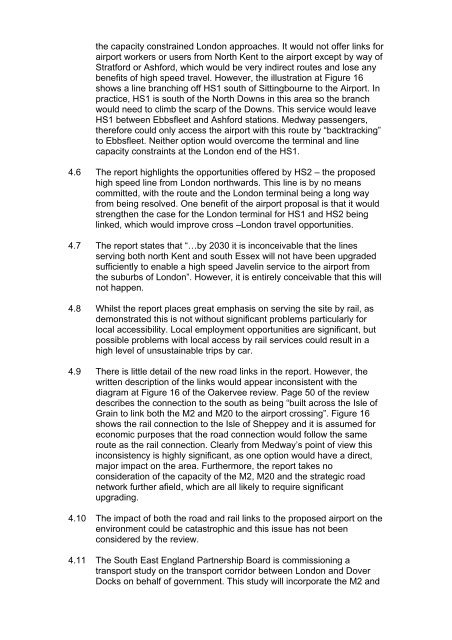1. Ecological objections - London
1. Ecological objections - London
1. Ecological objections - London
You also want an ePaper? Increase the reach of your titles
YUMPU automatically turns print PDFs into web optimized ePapers that Google loves.
the capacity constrained <strong>London</strong> approaches. It would not offer links for<br />
airport workers or users from North Kent to the airport except by way of<br />
Stratford or Ashford, which would be very indirect routes and lose any<br />
benefits of high speed travel. However, the illustration at Figure 16<br />
shows a line branching off HS1 south of Sittingbourne to the Airport. In<br />
practice, HS1 is south of the North Downs in this area so the branch<br />
would need to climb the scarp of the Downs. This service would leave<br />
HS1 between Ebbsfleet and Ashford stations. Medway passengers,<br />
therefore could only access the airport with this route by “backtracking”<br />
to Ebbsfleet. Neither option would overcome the terminal and line<br />
capacity constraints at the <strong>London</strong> end of the HS<strong>1.</strong><br />
4.6 The report highlights the opportunities offered by HS2 – the proposed<br />
high speed line from <strong>London</strong> northwards. This line is by no means<br />
committed, with the route and the <strong>London</strong> terminal being a long way<br />
from being resolved. One benefit of the airport proposal is that it would<br />
strengthen the case for the <strong>London</strong> terminal for HS1 and HS2 being<br />
linked, which would improve cross –<strong>London</strong> travel opportunities.<br />
4.7 The report states that “…by 2030 it is inconceivable that the lines<br />
serving both north Kent and south Essex will not have been upgraded<br />
sufficiently to enable a high speed Javelin service to the airport from<br />
the suburbs of <strong>London</strong>”. However, it is entirely conceivable that this will<br />
not happen.<br />
4.8 Whilst the report places great emphasis on serving the site by rail, as<br />
demonstrated this is not without significant problems particularly for<br />
local accessibility. Local employment opportunities are significant, but<br />
possible problems with local access by rail services could result in a<br />
high level of unsustainable trips by car.<br />
4.9 There is little detail of the new road links in the report. However, the<br />
written description of the links would appear inconsistent with the<br />
diagram at Figure 16 of the Oakervee review. Page 50 of the review<br />
describes the connection to the south as being “built across the Isle of<br />
Grain to link both the M2 and M20 to the airport crossing”. Figure 16<br />
shows the rail connection to the Isle of Sheppey and it is assumed for<br />
economic purposes that the road connection would follow the same<br />
route as the rail connection. Clearly from Medway’s point of view this<br />
inconsistency is highly significant, as one option would have a direct,<br />
major impact on the area. Furthermore, the report takes no<br />
consideration of the capacity of the M2, M20 and the strategic road<br />
network further afield, which are all likely to require significant<br />
upgrading.<br />
4.10 The impact of both the road and rail links to the proposed airport on the<br />
environment could be catastrophic and this issue has not been<br />
considered by the review.<br />
4.11 The South East England Partnership Board is commissioning a<br />
transport study on the transport corridor between <strong>London</strong> and Dover<br />
Docks on behalf of government. This study will incorporate the M2 and
















